【湖南师大内部资料】高二英语课件:(牛津译林版)m7-u4 grammar-1
文档属性
| 名称 | 【湖南师大内部资料】高二英语课件:(牛津译林版)m7-u4 grammar-1 | 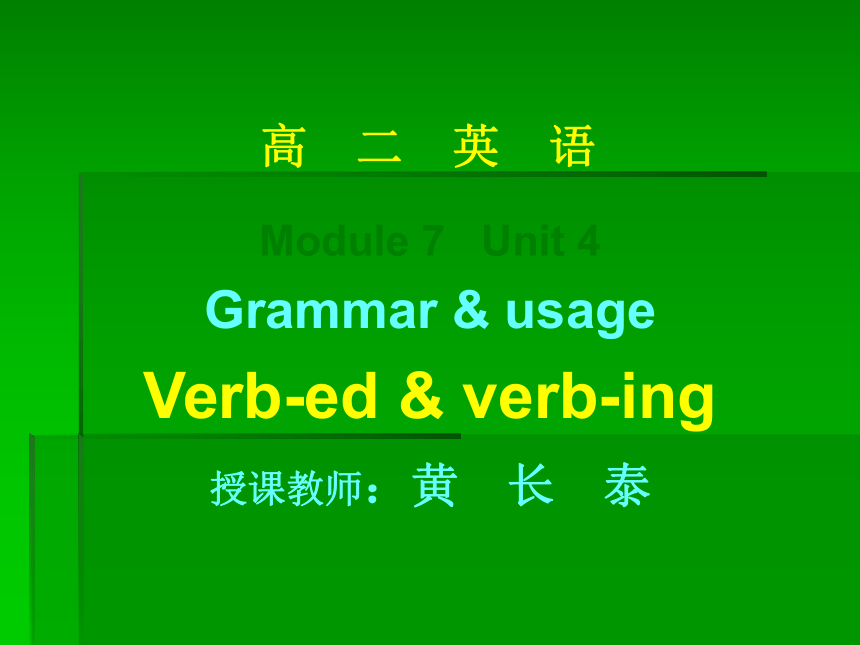 | |
| 格式 | rar | ||
| 文件大小 | 42.3KB | ||
| 资源类型 | 教案 | ||
| 版本资源 | 牛津译林版 | ||
| 科目 | 英语 | ||
| 更新时间 | 2011-04-03 15:51:00 | ||
图片预览


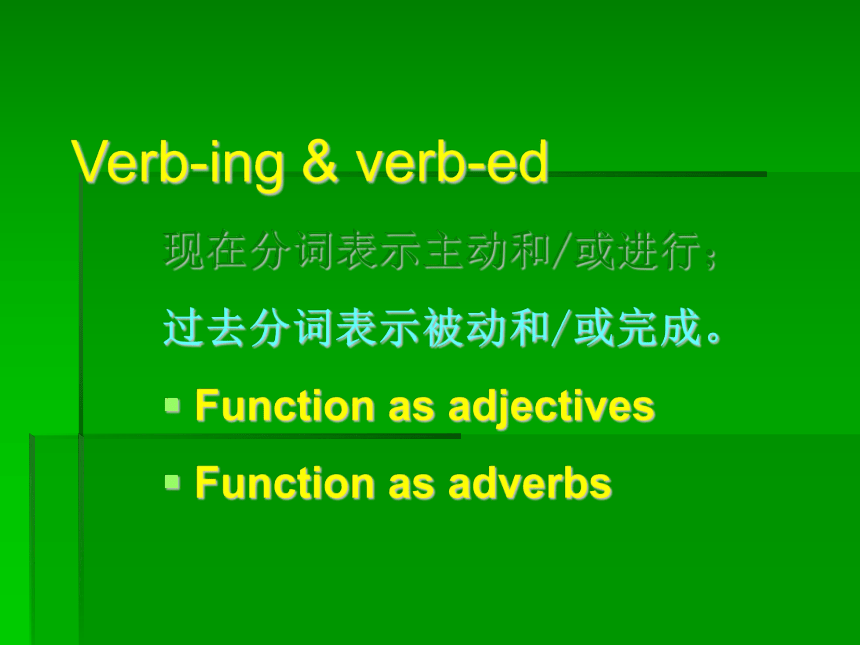
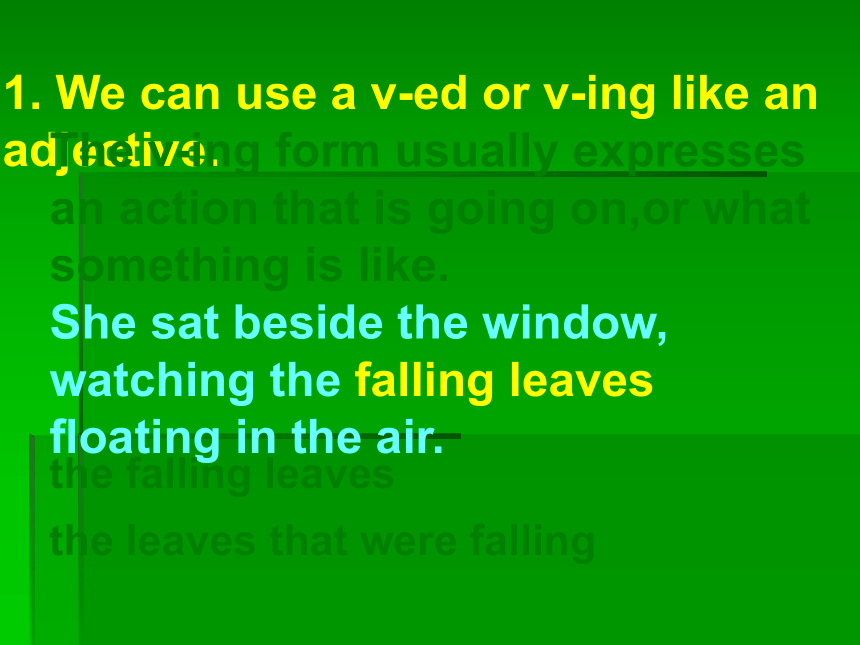
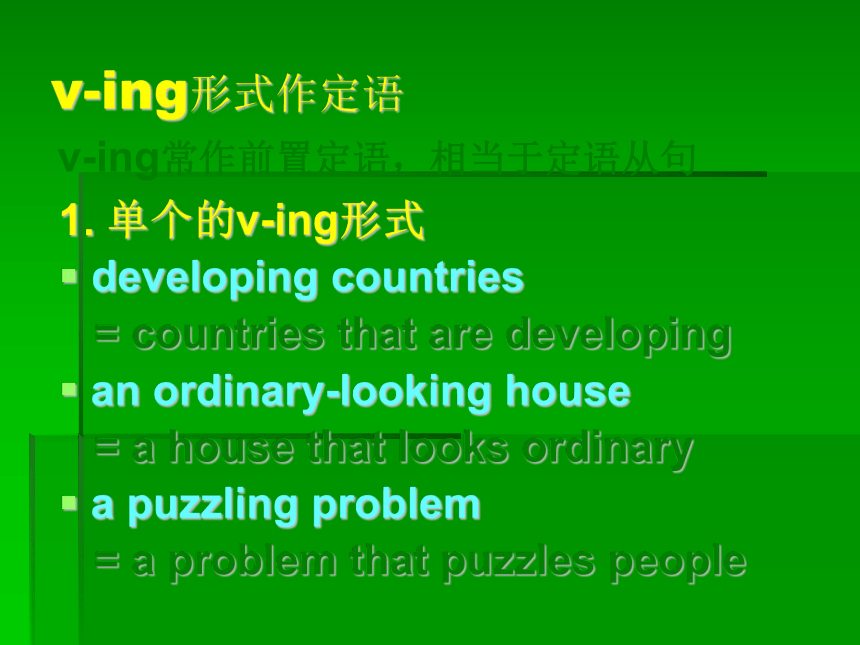
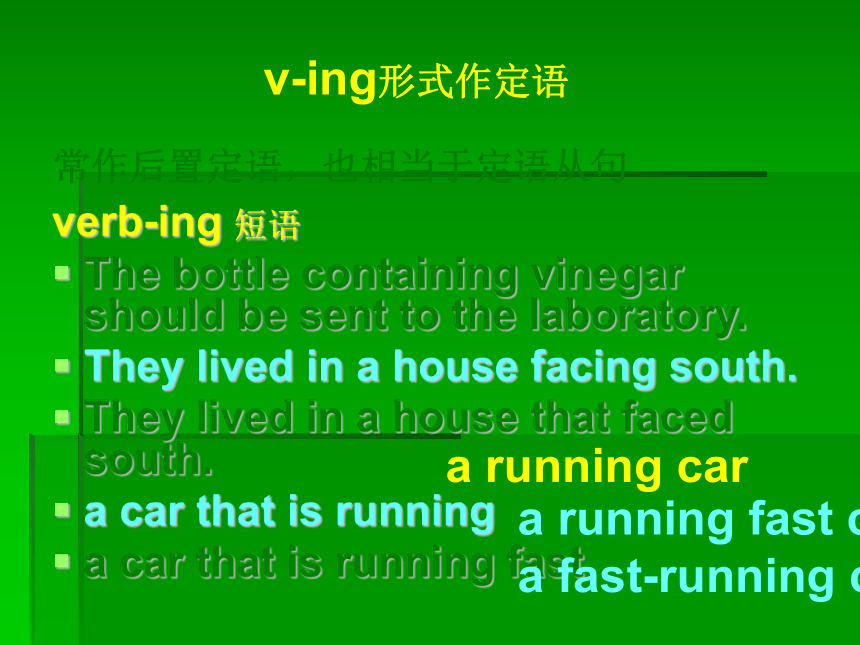




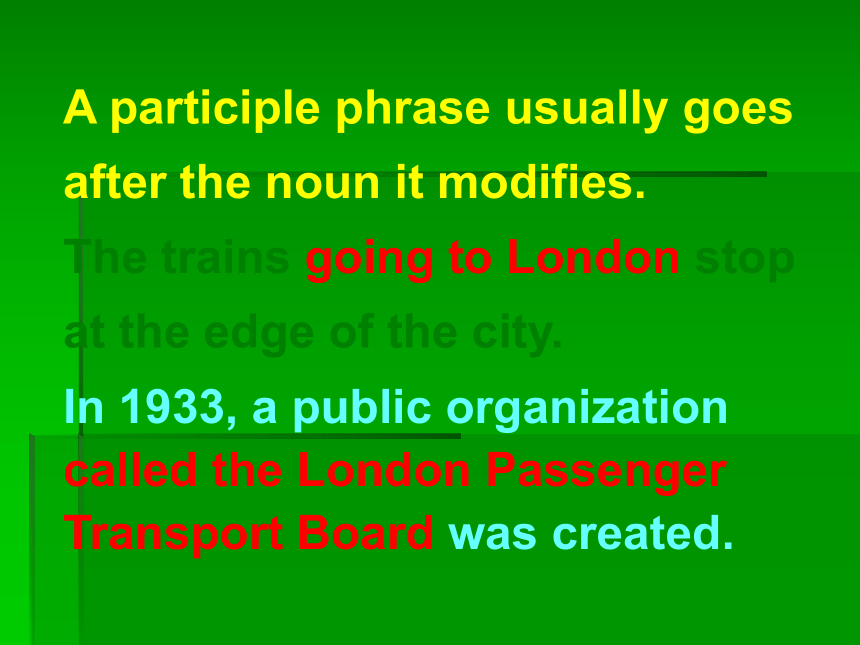
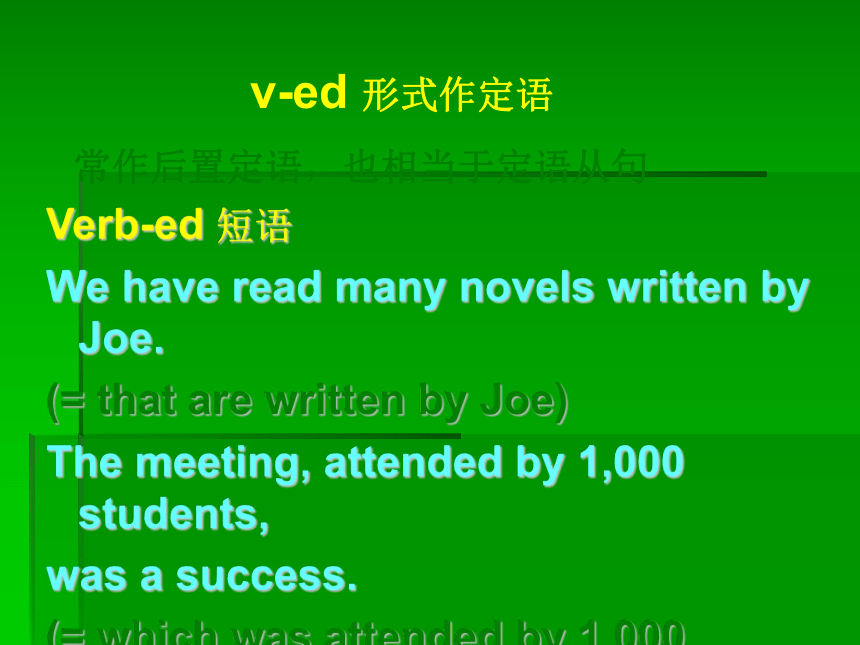
文档简介
课件34张PPT。高 二 英 语Module 7 Unit 4
Grammar & usage
Verb-ed & verb-ing授课教师:黄 长 泰Verb-ing & verb-ed Verb-ed & verb-ing are often called participles. We can use them as an attribute to modify a noun, or as an adverbial of time, cause, result, manner, etc. 动词的-ed 和动词的-ing词常常被称作分词。常常用来修饰名词,用作定语,或者被用作时间状语、原因状语、结果状语、方式状语等。Verb-ing & verb-ed 现在分词表示主动和/或进行;
过去分词表示被动和/或完成。
Function as adjectives
Function as adverbs1. We can use a v-ed or v-ing like an adjective.The v-ing form usually expresses an action that is going on,or what something is like.
She sat beside the window, watching the falling leaves floating in the air.the falling leaves
the leaves that were fallingv-ing形式作定语1. 单个的v-ing形式
developing countries
= countries that are developing
an ordinary-looking house
= a house that looks ordinary
a puzzling problem
= a problem that puzzles people v-ing常作前置定语,相当于定语从句verb-ing 短语
The bottle containing vinegar should be sent to the laboratory.
They lived in a house facing south.
They lived in a house that faced south.
a car that is running
a car that is running fast常作后置定语,也相当于定语从句v-ing形式作定语a running cara running fast car
a fast-running car某些情况下,定语不能用 v-ing 形式,必须用定语从句。① 作定语的动词-ing形式表示的动作要与主句 谓语的动作同时发生,如两者不能同时发生的话,则需使用定语从句。 昨天来的教授将要给我们作一个讲座。
【误】The professor coming here yesterday will
give us a lecture.
【正】The professor who came here yesterday
will give us a lecture. 某些情况下,定语不能用v-ing 形式,必须用定语从句。② v-ing形式的完成式不作定语,只作状语。
被地震毁坏的庙宇很快就要重建了。
【误】The temple having been destroyed by the earthquake will be rebuilt soon.
【正】The temple which has been destroyed by the earthquake will be rebuilt soon.
The v-ed form usually expresses the passive meaning, or refers to a finished action, or tells how we feel about something.
The police found the stolen car.
the stolen car = the car that is / was stolenThere was a thick layer of fallen leaves on the ground…
fallen leaves = leaves that were fallenv-ed形式作定语 单个动词-ed形式作定语
A watched pot never boils. 心急锅不开。
All the broken doors and windows have been repaired.
When we arrived, we each were given a printed question paper.
如表示强调,单个v-ed形式也可作后置定语。
Money spent is more than money earned. 入不敷出。常作前置定语,相当于定语从句A participle phrase usually goes after the noun it modifies.
The trains going to London stop at the edge of the city.In 1933, a public organization called the London Passenger Transport Board was created.Verb-ed 短语
We have read many novels written by Joe.
(= that are written by Joe)
The meeting, attended by 1,000 students,
was a success.
(= which was attended by 1,000 students)常作后置定语,也相当于定语从句v-ed 形式作定语v-ing & v-ed 作定语的区别 1. 及物动词的-ing形式作定语表示与被修饰名词是主动关系,及物动词的-ed 形式表示与被修饰名词是被动关系。
The group called Green Hand is trying to help protect the environment.
The group calling itself Green Hand is trying to help protect the environment.2. 不及物动词-ing形式表示动词正在进行,而-ed形式表示动作已完成,并不带有被动的含义。
falling leaves?正在飘落的叶子
fallen leaves?落叶
an escaped prisoner
= a prisoner who has escaped 逃犯
a retired worker
= a worker who has retired 退休工人v-ing & v-ed 作定语的区别2. We can use a v-ed or v-ing like an adverb.The v-ing or v-ed can be used to express reason or cause.
Realizing he would have to take two different trains, he decided to take a taxi instead.Encouraged by the success of the Metropolitan Railway Company, the Metropolitan District Railway opened another line in 1868.The v-ing or v-ed can be used to refer time.
Travelling through the tunnel, the man felt uncomfortable because of the noise.When asked how old the underground system was, she made no reply.The v-ing or v-ed can be used to express manner.
The train headed for London, puffing and ratting.The v-ing or v-ed can be used to express condition.
Turning to the left at the crossroads, you will see the railway station on your right.v-ing 形式作状语 动词-ing形式可以作状语,修饰动词,其动作执行者与句子主语是主动一致。在句中表示时间、原因、结果、条件、让步、行为方式或伴随情况等。
动词-ing形式作时间、原因、条件、让步状语时多位于句首;作结果、伴随情况状语时常位于句末。1. 表示时间,相当于一个时间状语从句。
Having made full preparations, we are ready for the examination.
(= After we have made full preparations...)
2. 表示原因,相当于一个原因状语从句。
Being ill, he didn't go to school yesterday.
(= Since he was ill...)
3. 表示结果,相当于一个并列谓语。
His father died, leaving him a lot of money.
(= and left him a lot of money.)4. 表示条件,相当于一个条件状语从句。
Working hard at your lessons, you’ll succeed.
=If you work hard at your lessons...
5. 表示让步,相当于一个让步状语从句。
Knowing all this, they made me pay for the damage.
= Although they knew all this...
6. 表示行为方式、伴随情况或补充说明,相当于一个并列结构。
He lay on the grass, staring at the sky for a long time.
= ...and stared at the sky for a long time 动词-ed形式作状语和动词-ing形式作状语一样,也可以表示时间、原因、条件、让步、方式或伴随情况等。但其动作执行者与句子主语是被动一致。v-ed 形式作状语1 动词-ed形式作状语表示时间,相当于一个时间状语从句。
Seen from the tower, the city looks beautiful.
= When the city is seen from the tower, it ...
有时动词-ed形式前可加连词when, while等来强调时间概念。
When heated, metals will expand a little bit.
When metals are heated, they will expand a little bit.V-ed 形式作状语2. v-ed 形式作状语表示原因,相当于一个原因状语从句。
Moved by the heroic deeds, the children couldn't help crying.
(= Since they were moved by the heroic deeds...)
3. v-ed 形式作状语表示条件, 相当于一个条件状语从句。
Heated, water changes into steam.
(= If water is heated, it changes into steam.)V-ed 形式作状语4. 动词-ed形式作状语表示让步,相当于一个though/although引导的让步状语从句。
Exhausted by the running, they went on running after the robber.
(= Although they were exhausted by the running, they went on running after the robber.)V-ed 形式作状语 为了使-ed形式表示的条件、动词让步意义更加明显,我们可以加上适当的连词。
Even if invited, I won't go.
I won’t go even if I am invited.
Though beaten by them, we did not lose heart.
We didn’t lose heart, though we had been beaten by them.
Unless invited, he will not come back to the company.
I will not come back to the company unless I am invited.V-ed 形式作状语5. 动词-ed形式作状语表示行为方式、伴随情况或补充说明时,通常位于句子的后面,相当于一个并列分句。
The teacher stood there, surrounded by the students.
(=… and he was surrounded by the students.)V-ed 形式作状语 Tell the functions:
Completely examined by the doctors, he went back to school right away.
Having lived in this city for three years, she knows it very well.
Laughed at by many people, he continued his study.
He went into the office, followed by many children. 时间原因让步伴随3. A v-ing can have passive and
perfect forms.We use being + v-ed to form the continuous
The underground system being built in the city will be open next year.We can use having + v-ed and having been +v-ed to make the active and passive perfect forms.
Having seen the situation, a wealthy American businessman, Charles Yerkes, tried to improve the system.Having been developed over many years, the underground system is now able to transport millions of people effectively.Answers (P57): (6) tired
(7) surprising
(8) relaxing
(9) excited
(10) disappointed(1) pleased
(2) interesting
(3) confusing
(4) annoying
(5) amusedAnswers (P128):
(1) tired
(2) smoking
(3) Having been repaired
(4) cleaned
(5) trying broken
(6) wasted attempting
(7) Considering
(8) puzzling confusedAnswers (P128):
(1) developing developed
(2) Bored boring
(3) Surprised surprisingAnswers (P128):
(1) tired
(2) Smoking
(3) Having been repaired
(4) cleaned
(5) trying broken
(6) wasted attempting
(7) Considering
(8) puzzling confusedHomeworkWorkbook C1 & C 2
Grammar & usage
Verb-ed & verb-ing授课教师:黄 长 泰Verb-ing & verb-ed Verb-ed & verb-ing are often called participles. We can use them as an attribute to modify a noun, or as an adverbial of time, cause, result, manner, etc. 动词的-ed 和动词的-ing词常常被称作分词。常常用来修饰名词,用作定语,或者被用作时间状语、原因状语、结果状语、方式状语等。Verb-ing & verb-ed 现在分词表示主动和/或进行;
过去分词表示被动和/或完成。
Function as adjectives
Function as adverbs1. We can use a v-ed or v-ing like an adjective.The v-ing form usually expresses an action that is going on,or what something is like.
She sat beside the window, watching the falling leaves floating in the air.the falling leaves
the leaves that were fallingv-ing形式作定语1. 单个的v-ing形式
developing countries
= countries that are developing
an ordinary-looking house
= a house that looks ordinary
a puzzling problem
= a problem that puzzles people v-ing常作前置定语,相当于定语从句verb-ing 短语
The bottle containing vinegar should be sent to the laboratory.
They lived in a house facing south.
They lived in a house that faced south.
a car that is running
a car that is running fast常作后置定语,也相当于定语从句v-ing形式作定语a running cara running fast car
a fast-running car某些情况下,定语不能用 v-ing 形式,必须用定语从句。① 作定语的动词-ing形式表示的动作要与主句 谓语的动作同时发生,如两者不能同时发生的话,则需使用定语从句。 昨天来的教授将要给我们作一个讲座。
【误】The professor coming here yesterday will
give us a lecture.
【正】The professor who came here yesterday
will give us a lecture. 某些情况下,定语不能用v-ing 形式,必须用定语从句。② v-ing形式的完成式不作定语,只作状语。
被地震毁坏的庙宇很快就要重建了。
【误】The temple having been destroyed by the earthquake will be rebuilt soon.
【正】The temple which has been destroyed by the earthquake will be rebuilt soon.
The v-ed form usually expresses the passive meaning, or refers to a finished action, or tells how we feel about something.
The police found the stolen car.
the stolen car = the car that is / was stolenThere was a thick layer of fallen leaves on the ground…
fallen leaves = leaves that were fallenv-ed形式作定语 单个动词-ed形式作定语
A watched pot never boils. 心急锅不开。
All the broken doors and windows have been repaired.
When we arrived, we each were given a printed question paper.
如表示强调,单个v-ed形式也可作后置定语。
Money spent is more than money earned. 入不敷出。常作前置定语,相当于定语从句A participle phrase usually goes after the noun it modifies.
The trains going to London stop at the edge of the city.In 1933, a public organization called the London Passenger Transport Board was created.Verb-ed 短语
We have read many novels written by Joe.
(= that are written by Joe)
The meeting, attended by 1,000 students,
was a success.
(= which was attended by 1,000 students)常作后置定语,也相当于定语从句v-ed 形式作定语v-ing & v-ed 作定语的区别 1. 及物动词的-ing形式作定语表示与被修饰名词是主动关系,及物动词的-ed 形式表示与被修饰名词是被动关系。
The group called Green Hand is trying to help protect the environment.
The group calling itself Green Hand is trying to help protect the environment.2. 不及物动词-ing形式表示动词正在进行,而-ed形式表示动作已完成,并不带有被动的含义。
falling leaves?正在飘落的叶子
fallen leaves?落叶
an escaped prisoner
= a prisoner who has escaped 逃犯
a retired worker
= a worker who has retired 退休工人v-ing & v-ed 作定语的区别2. We can use a v-ed or v-ing like an adverb.The v-ing or v-ed can be used to express reason or cause.
Realizing he would have to take two different trains, he decided to take a taxi instead.Encouraged by the success of the Metropolitan Railway Company, the Metropolitan District Railway opened another line in 1868.The v-ing or v-ed can be used to refer time.
Travelling through the tunnel, the man felt uncomfortable because of the noise.When asked how old the underground system was, she made no reply.The v-ing or v-ed can be used to express manner.
The train headed for London, puffing and ratting.The v-ing or v-ed can be used to express condition.
Turning to the left at the crossroads, you will see the railway station on your right.v-ing 形式作状语 动词-ing形式可以作状语,修饰动词,其动作执行者与句子主语是主动一致。在句中表示时间、原因、结果、条件、让步、行为方式或伴随情况等。
动词-ing形式作时间、原因、条件、让步状语时多位于句首;作结果、伴随情况状语时常位于句末。1. 表示时间,相当于一个时间状语从句。
Having made full preparations, we are ready for the examination.
(= After we have made full preparations...)
2. 表示原因,相当于一个原因状语从句。
Being ill, he didn't go to school yesterday.
(= Since he was ill...)
3. 表示结果,相当于一个并列谓语。
His father died, leaving him a lot of money.
(= and left him a lot of money.)4. 表示条件,相当于一个条件状语从句。
Working hard at your lessons, you’ll succeed.
=If you work hard at your lessons...
5. 表示让步,相当于一个让步状语从句。
Knowing all this, they made me pay for the damage.
= Although they knew all this...
6. 表示行为方式、伴随情况或补充说明,相当于一个并列结构。
He lay on the grass, staring at the sky for a long time.
= ...and stared at the sky for a long time 动词-ed形式作状语和动词-ing形式作状语一样,也可以表示时间、原因、条件、让步、方式或伴随情况等。但其动作执行者与句子主语是被动一致。v-ed 形式作状语1 动词-ed形式作状语表示时间,相当于一个时间状语从句。
Seen from the tower, the city looks beautiful.
= When the city is seen from the tower, it ...
有时动词-ed形式前可加连词when, while等来强调时间概念。
When heated, metals will expand a little bit.
When metals are heated, they will expand a little bit.V-ed 形式作状语2. v-ed 形式作状语表示原因,相当于一个原因状语从句。
Moved by the heroic deeds, the children couldn't help crying.
(= Since they were moved by the heroic deeds...)
3. v-ed 形式作状语表示条件, 相当于一个条件状语从句。
Heated, water changes into steam.
(= If water is heated, it changes into steam.)V-ed 形式作状语4. 动词-ed形式作状语表示让步,相当于一个though/although引导的让步状语从句。
Exhausted by the running, they went on running after the robber.
(= Although they were exhausted by the running, they went on running after the robber.)V-ed 形式作状语 为了使-ed形式表示的条件、动词让步意义更加明显,我们可以加上适当的连词。
Even if invited, I won't go.
I won’t go even if I am invited.
Though beaten by them, we did not lose heart.
We didn’t lose heart, though we had been beaten by them.
Unless invited, he will not come back to the company.
I will not come back to the company unless I am invited.V-ed 形式作状语5. 动词-ed形式作状语表示行为方式、伴随情况或补充说明时,通常位于句子的后面,相当于一个并列分句。
The teacher stood there, surrounded by the students.
(=… and he was surrounded by the students.)V-ed 形式作状语 Tell the functions:
Completely examined by the doctors, he went back to school right away.
Having lived in this city for three years, she knows it very well.
Laughed at by many people, he continued his study.
He went into the office, followed by many children. 时间原因让步伴随3. A v-ing can have passive and
perfect forms.We use being + v-ed to form the continuous
The underground system being built in the city will be open next year.We can use having + v-ed and having been +v-ed to make the active and passive perfect forms.
Having seen the situation, a wealthy American businessman, Charles Yerkes, tried to improve the system.Having been developed over many years, the underground system is now able to transport millions of people effectively.Answers (P57): (6) tired
(7) surprising
(8) relaxing
(9) excited
(10) disappointed(1) pleased
(2) interesting
(3) confusing
(4) annoying
(5) amusedAnswers (P128):
(1) tired
(2) smoking
(3) Having been repaired
(4) cleaned
(5) trying broken
(6) wasted attempting
(7) Considering
(8) puzzling confusedAnswers (P128):
(1) developing developed
(2) Bored boring
(3) Surprised surprisingAnswers (P128):
(1) tired
(2) Smoking
(3) Having been repaired
(4) cleaned
(5) trying broken
(6) wasted attempting
(7) Considering
(8) puzzling confusedHomeworkWorkbook C1 & C 2
